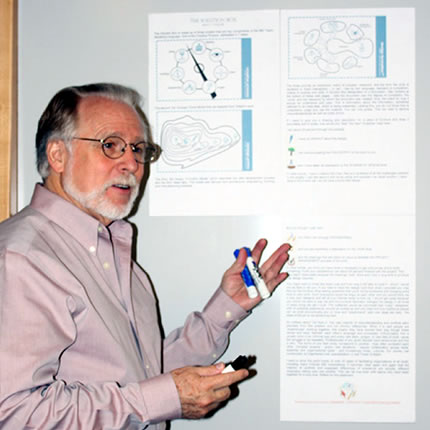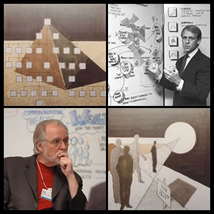\
Transforming the 21st Century Organization
|
 |
| As this part of my web site is autobiographical, and as my experience of this still arcane science and art is critical to the subject, the remarks provides a context for this Paper: On this past June 16th, I completed my 52nd year of professional work. This coming June 16th I will be 70 years old having entered school during WWII and subsequently walked the streets of a city, a little over a year after the war, where 100 thousand people died in one night of fire bombing. This means I have witnessed, and participated in, the global transformation which is sweeping our planet and is now reaching its most critical moment. In 1975, I first taught my ReDesigning the Future course the objective of which was to prepare people for the changes they faced, both personally and organizationally, for the coming world of the 21st Century. This lead directly to the Formation of MG Taylor, the DesignShop® process and the creation of NavCenter® environments. Today, a process based on our Patent is going on virtually every day somewhere on Earth. From the viewpoint of the past generation of my work, we are entering the cusp point of a global technical-economic, social and political transformation for which we, as a species, in our many organizations, and as individuals, are ill prepared. We fundamentally lack the models, organizational means, focus and will necessary to take hold of the process we ourselves have created yet do not recognize, claim or understand. |
|
the Science and Art of Transition Management
a FutureViews™ Exercise |
| This Paper, was started on July 4th 2008. It will take a number of months to complete even though it will be linked to a number of pieces I have written over the years. It is a summary of over 30 years of applied research and client work in the arena of organizational transformation. |
| I encourage any reader who is interested in this subject to return often to this subject as the documentation process, itself, reveals much about the subject. Even in its early stages, the amount of content and references will be more than can be absorbed with ease. |
| The transformation of human organizations is not an easy task and from my point of view its often approached carelessly with the task under funded, underestimated, not adequately designed and therefore without any real hope of success. Too often, this is attempted without adequate knowledge of the greater changes surrounding the organization nor an understanding and sensitivity for the individuals who make it up. |
|
|
The stimulus for writing this, at this time in my life when I am occupied with may other concerns, was a recent DesignShop® event where I was struck with the gap between the intent of the team, the enormity of their task and their lack of the tools, knowledge and processes to achieve the work ahead. |
| These were very smart and hard working people with a strong will to succeed. From the vantage point of my experience, however, this team has a extraordinary mountain to climb and almost no time to prepare for the climb and little awaresness of the dangers ahead. |
| I wish them well and hope that the following words will be helpful. Their specific situation will be kept in confidence, of course. This writing will tell of many experiences drawn from both the past and present. In that no specific references will be made that are not already public or have been authorized, it is posted on the public side of my web site in order that others following this path will benefit. Transformation, as we shall see, is not accomplished alone. |
|
|
| Transformation is both a science and an art. The bridge between these two is the craft of engineering. What can be engineered is the environment in which the transformation takes place. In the Taylor System and Method, we call these the 7 Domains. These can be managed, people cannot be managed. |
| Transformation of an individual, a team, an organization, city, region, country, country, or world is an emergent property. It cannot be understood, made to happen or controlled. The conditions which foster it can be deliberately created. Transformation cannot be measured. It is possible to install feedback loops which create a sustainable living, learning system. This is the work of the Transition Manager. |
| The transformation of an individual, organization or a larger societal entity cannot be accomplished in a vacuum. Those who attempt an organizational transformation without knowledge of, concern for, and involvement of, the people within it and the society around it, will surly fail. Unfortunately, this is usually the case as the too narrow definition of the “practical” obscures all the true facts of the matter. Complexity and requisite variety cannot be ignored with impunity. |
|
|
This Paper will cover the subject of transformation on three levels: the theory and description of it; the strategy and design of the transformational process; and, the multifaceted work of doing it. By necessity, this will be a book length exploration. Someday, it may even become a book. |
| There are no short cuts to the act of successfully leading an organization through the transformational process. There not cooke cutter approaches - no “best practices” as these are thought of today. Attempts to conduct a transformation this way ignore the complexity involved. As a consequence many people are hurt, treasure is lost and the possibility of a human transformation becomes more suspect. |
| The motives which drive most organizations to a scale and scope of change that can be called a transformation are usually the wrong ones. The drive of most leadership to get to the desired result causes them to skip the work of creating the necessary means for achieving that result. As a consequence, most attempts at transformation do not end with success - they burn out or outright crash. With proper design and restrained, measured execution, this does not have to be the case. |
|
|
| As transformation does not take place in a vacuum, both an individual and social phenomena have to be understood. In recent times, we have tended to think of organizations - particularly the corporation - as something outside of society and not subject to the same principles and rules. This is both foolish - as it is not true - and dangerous - when one looks at the typical results. |
| Work and enterprise is a normal part of life and an integral part of every society. The motive, when divorced from all other human concerns, “to make money” has become one of the major distortions of our time. Huge crimes are being committed in its name. Most of these against people at work. This is not, as is commonly charged, something only happening to those referred to as “the working poor.” The price paid by those on top of the pyramid is just as grievous despite the trappings of wealth and power. |
| To ignore this when seeking to bring about organizational transformation is to partake in delusion and ultimately violation of the human spirit. When this happens, the possibility of an organizational transformation approaches zero. A negative synergy builds pushing away the positive. |
|
|
Too often now, the concept transformation has become a code word for something of an entirely different nature.The wonderful system of commerce, we have created over many centuries, is manipulated to extract huge unsustainable returns from an organization and its people at the expense of everything creative and human. These are acts of violence. The tragic aspect is that with creativity and good design this is not necessary. |
| Organized violence of this kind spills out and does great harm to society, all forms of life, and the planet. While always tragic, in times past this was less damaging as human powers where far simpler, the earth more open, and the consequences less systemic. No more. It is no longer feasible to optimize one organization at the expense of others or the system of which they are a part. Organizations do not compete - their services and products do for the attention and loyalty of their users. A free market facilitates choice - not wisdom. |
| Transformation means to change form. Its effects ripple throughout the entire system of human enterprise which in turn changes and responds. In a world of rapid, continuous communication and feedback, these effects, like ocean waves, cross and re cross one another producing one step function after another. |
|
|
|
|
|
|
The Transformation Process |
|
|
|
| |
|
|
|
| |
|
|
|
posted: July 4, 2008 • revised August 12, 2008 |
|

